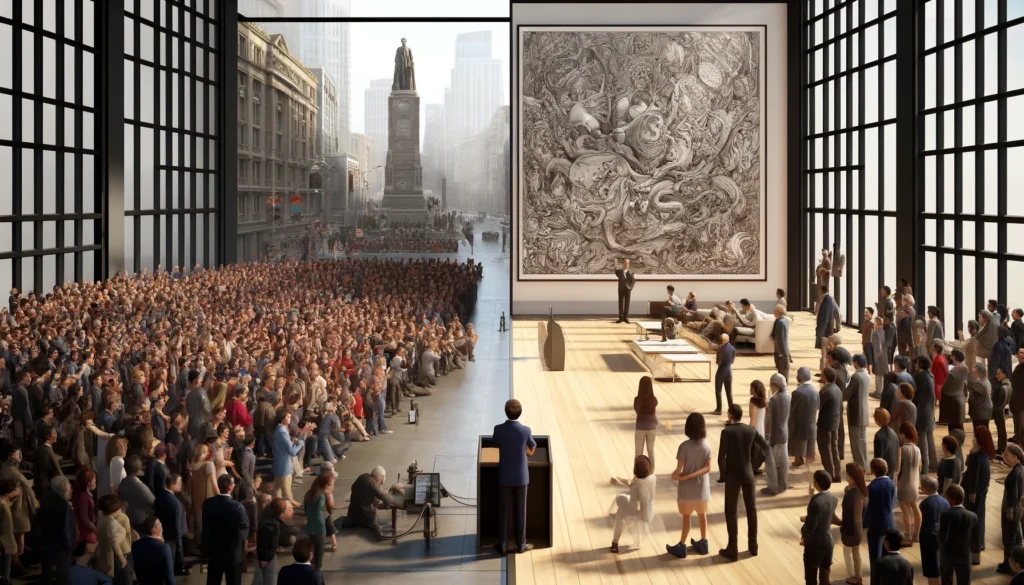
Introduction
What if history had taken a different path? What if Adolf Hitler, a name synonymous with tyranny and destruction, had been accepted into the Vienna Academy of Fine Arts? This article explores an alternate timeline, one where Hitler pursued canvases instead of conquests. We delve into historical contexts, Hitler’s aspirations as an artist trying to answer the question “What If Hitler Was Accepted In The Art Academy” or What If Hitler became known as, Adolf Hitler The Great Painter, and the potential impacts on the world had he become a painter rather than a political leader.
The Ripple of a Rejection
In 1907 and again in 1908, a young Adolf Hitler applied to the Academy of Fine Arts Vienna, only to face rejection both times. This pivotal moment in history left an indelible mark on the world, as Hitler later rose to infamy as the dictator of Nazi Germany. But what if the Academy had accepted him instead? This thought experiment explores an alternate reality, where Hitler pursued a career in art instead of politics. Through historical context and imagined scenarios, we delve into how this single change could have reshaped global events, Hitler’s life, and the world as we know it.
Early Life and Artistic Aspirations | The Turning Point
Adolf Hitler moved to Vienna in 1907 with dreams of becoming an artist. His early life in Austria was full of a passion for painting and architecture. Despite showing some talent, he prestigious Academy rejected his applications, primarily due to his insufficient artistic skill in the eyes of the examiners. If accepted, Hitler might have embarked on a vastly different path, immersing himself in the artistic community of Vienna, a hub for some of Europe’s most progressive art and ideas at the time.
A Different Path: The Art Student
Accepted into the Academy, Good for Hitler, Hitler would have found himself among peers and mentors who could nurture his artistic growth. The academic environment, focused on creativity and expression, might have softened his views, which were later hardened by rejection and failure. As an art student, Hitler could have developed a career that channeled his intense energies and ambitions into canvas and sculpture rather than political and military conquest.
The Art Scene in Early 20th Century Vienna
Vienna was a melting pot of artistic innovation in the early 1900s, home to figures like Gustav Klimt and Egon Schiele. Surrounded by these influences, Hitler might have been inspired to refine his art style, possibly leading to a successful career in the arts. This section explores how the vibrant cultural scene could have impacted his artistic development and worldview.
Nurturing Creativity in a Cultural Melting Pot
In early 20th century Vienna, a hub of artistic and intellectual exchange, diverse influences ranged from traditional to avant-garde. Accepted into the Academy of Fine Arts, Hitler would have been part of Vienna’s vibrant cultural scene. Exposure to diverse styles and works by Klimt and Schiele might have deeply influenced Hitler’s artistic growth. In a dynamic community, Hitler would have been pushed to radically change his style, moving beyond traditional landscapes. This artistic transformation might have provided Hitler a creative outlet, potentially diverting his energies from his later destructive path.
Altering Ideologies Through Artistic Interaction
Vienna’s diverse, inclusive art scene, with substantial Jewish influence, could have reshaped Hitler’s ideological views significantly. Regular interactions with Jewish artists, critics, and patrons might have challenged and altered his anti-Semitic beliefs, promoting harmony. Being in a community with respected Jewish members could have fostered empathy, lessening prejudices driving his politics. Appreciation in this inclusive artistic environment might have dramatically changed Hitler’s development, influencing more tolerant, diverse political attitudes.”
Impact on Personal Beliefs and Ideology of Adolf Hitler
As mentioned above, Art school could have exposed Hitler to diverse cultures and ideologies, potentially altering his political views. Engagement with Jewish artists and intellectuals in Vienna’s art scene could have dispelled Hitler’s anti-Semitic beliefs early on. This scenario explores how personal and professional relationships within this community could have reshaped his ideological outlook.
The Butterfly Effect: A World Without Hitler the Politician
Without Hitler’s political leadership, the trajectory of the Nazi Party and Germany’s future would have been drastically different. This section considers how Europe might have avoided the Third Reich, Holocaust, and WWII, saving millions and altering history.
Averting the Rise of the Third Reich
Without Adolf Hitler’s charismatic yet malevolent leadership, the trajectory of the Nazi Party might have been significantly different. Hitler’s manipulation, fear-inspiring tactics, and exploitation of Weimar crises were crucial to his rise to power. Without him at the helm, the Nazi Party could have struggled to gain the same traction it did historically. Without his propaganda and speeches, the Nazi movement might have been weaker, struggling to effectively consolidate power. This fragmentation could have allowed moderate or democratic forces in Germany to gain influence before World War II.
Preventing the Holocaust and Its Global Impacts
“The Holocaust, a horrific genocide, resulted from Hitler’s anti-Semitism and dictatorial control over Germany. Without Hitler’s anti-Semitic policies and government execution, the extermination of millions could have been avoided. The absence of this genocide could have preserved diverse cultures and enriched Europe’s cultural and intellectual landscape. Additionally, no Holocaust would have profoundly impacted global relations and shaped international law and human rights post-WWII.
Changing the Landscape of World War II
“Without Hitler’s ideology and expansionist policies, World War II’s course could have drastically changed. Also, without Hitler, Germany might not have pursued extensive territorial expansion across Europe. Without him, the conflict might have been delayed or featured less focus on Blitzkrieg and genocide. Different dynamics among Britain, France, the Soviet Union, and the US could have avoided devastating battles. Additionally, Europe’s post-war boundaries and the Cold War’s onset could have led to a different global order.
Artistic Legacy of Hitler The Great Painter
Assuming Hitler had found success as an artist, this part imagines the nature of his contributions to art. Would Hitler’s success as a painter have reflected his intense character or presented something entirely unexpected? We explore the possible themes and styles of Hitler’s alternate career as a professional artist.
Influence on Contemporary and Future Art Movements
Hitler’s involvement in art could have influenced various art movements in Europe. His artistic style and success could have significantly influenced expressionism or other dominant trends of his era. This speculative analysis considers how one individual’s creative output could ripple through the art world.
Long-term Cultural Implications
Europe’s cultural landscape might have differed significantly with Hitler as an artist, not a destructive leader. This section explores the long-term impacts on cultural norms, values, and expression if Hitler had pursued art.
Reflections: The Interplay of Art and Destiny
This concluding section reflects on the interplay between individual choices and historical trajectories. It shows how personal successes or failures, like an art school application, can significantly shape history.
Conclusion: Lessons for the Present
The Profound Lessons of Alternate Histories
Concluding our exploration of this ‘what if’ scenario, we reflect on the profound lessons from alternate histories. Imagining Hitler accepted into art school highlights educational and cultural institutions’ roles in shaping history. This experiment emphasizes nurturing young artists, showing how these choices impact societal norms and history.
The Intersection of Art and Politics
Delving into how art and politics can intersect, this exploration serves as a potent reminder of their intertwined nature. The Vienna Academy’s acceptance or rejection of an applicant might have unknowingly changed the 20th century. This convergence of art, politics, and destiny prompts reflection on how minor personal changes could alter history.
Destiny, Choice, and Historical Impact
We ponder destiny and choice, reflecting on how individual and institutional decisions impact world history. These reflections highlight how opportunities, granted or denied, can significantly change individuals’ life paths.
By pondering these paths not taken, we gain insight into the broader implications of seemingly small but pivotal moments.
Concluding Reflections on a World Reshaped by Art
In conclusion, this article explores an alternate history, imagining Hitler as an artist, not a warmonger. Imagining this world provides unique insights into how individual choices ripple through history, enriching our understanding.
Read Also: Solar Eclipses: All what you need to know





